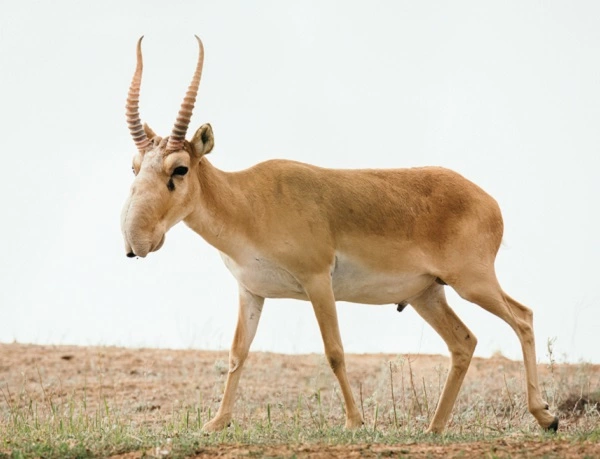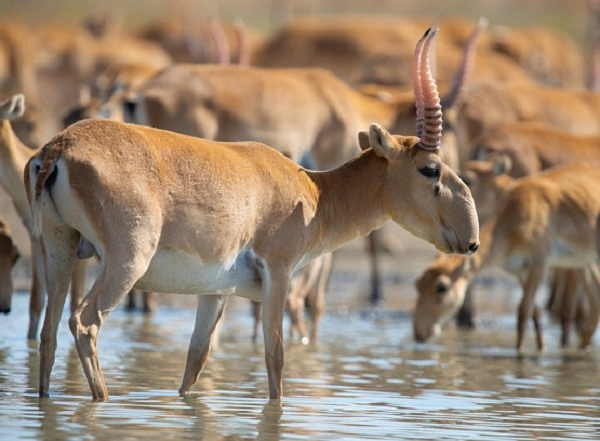The saiga antelope is a critically endangered species that may be unfamiliar to many people. These fascinating creatures have an interesting history and face a uncertain future.

Saiga Description
The Saiga antelope ( Saiga tatarica) is a critically endangered species of antelope that inhabits the steppes of Central Asia. The Saiga is easily recognizable by its distinctive long, bulbous nose, which helps to filter out dust and protect the lungs from cold weather. Saiga are social animals and live in herds of up to 100 individuals. These herds migrate seasonally in search of food and water. Saiga were once very common, but their population has declined by over 95% since the mid-1990s due to poaching and habitat loss. As a result, the Saiga is now listed as critically endangered by the IUCN Red List.
Saiga Habitat
Saigas are a critically endangered species of antelope that once ranged across much of Central Asia. Today, their population has declined sharply, and they are only found in a few isolated areas. Saigas inhabit semi-desert and steppe ecosystems, where they graze on grasses and other plants. They are well-adapted to the harsh conditions of their habitat, able to go without water for long periods of time and survive extremely cold winters. However, Saigas are highly susceptible to environmental changes and human disturbance. Their populations have been devastated by hunting, habitat loss, and disease outbreaks. As a result, Saigas are now classified as critically endangered by the International Union for Conservation of Nature (IUCN).
Despite their decline, Saigas continue to play an important role in the ecosystems they inhabit. They help to keep grasslands healthy by grazing on excess vegetation and preventing wildfires. They also provide food for predators such as wolves and eagles. In addition, Saigas are an important cultural icon in their native range, with a long history of being hunted for their meat and horns. For these reasons, it is essential to protect Saiga populations from further decline.
Saiga Diet
Saiga antelope are a type of hoofed mammal that can be found in parts of Central Asia. They are well-adapted to their arid habitat and have a number of physical characteristics that help them to survive in this environment. Saiga antelope are herbivores and primarily eat grasses and other plants. In the spring, they migrate to areas where there is more green vegetation available. During the winter, they eat dried grasses and shrubs. Saigas have a four-chamber stomach that helps them to digest their food properly. They also consume large quantities of water, which helps them to stay hydrated in their dry habitat.

Saiga Size
Saiga antelope are a species of antelope found in Asia. They are characterised by their large, distinctive horns and long, narrow faces. Saiga are relatively small animals, with adults ranging in size from 30 to 60 cm at the shoulder and weighing between 15 and 35 kg. However, despite their small stature, Saiga antelope are among the largest members of the family Bovidae, which includes cattle, buffalo and sheep. This is due to their relatively long legs and neck, which give them a taller appearance. Saiga antelope inhabit open steppe and semi-desert habitats in Russia, Kazakhstan, Uzbekistan, Mongolia and China. They are highly social animals and live in herds of up to 500 individuals. Saiga play an important role in the steppe ecosystem, as their grazing helps to keep grasslands healthy and prevent the spread of woody shrubs. Unfortunately, Saiga populations have declined sharply in recent years due to hunting and habitat loss. As a result, they are now considered to be a vulnerable species.
Saiga Lifespan
Saiga antelope are a critically endangered species of antelope found in Russia, Kazakhstan, Mongolia, and Uzbekistan. The largest population of Saiga antelope is found in Russia. Saiga antelope are well-adapted to their arid habitat and can go without water for long periods of time. They get most of the moisture they need from the plants they eat. Saiga antelope live in herds and travel great distances across the steppe in search of food and water. Saiga antelope have a lifespan of 10-15 years in the wild. However, their population has declined sharply in recent years due to poaching and habitat loss. As a result, Saiga antelope are now listed as critically endangered by the IUCN Red List. Saiga antelope are protected by law in all range countries, but more needs to be done to save this species from extinction.
Saiga Behavior
Saiga antelopes are a critically endangered species that once roamed the steppes of Eurasia in large herds. Today, their population has declined dramatically due to poaching and habitat loss, and they are now found only in small pockets in Russia, Kazakhstan, and Mongolia. Saigas are unique among antelopes for their long, curved noses, which help them filter out dust from the dry air of the steppe. They are also known for their uncommon social behaviors. Saigas live in large herds made up of both males and females, and they migrate great distances each year in search of food and water. These migrations often take them into areas where humans live, which has led to conflicts with people who see the Saigas as a threat to their crops or livestock. As a result of these conflicts and other threats, Saiga populations have declined sharply in recent years, and the future of this species is uncertain.
Saiga Speed
The Saiga Antelope is a species of antelope that is native to Central Asia. The Saiga is known for its distinctive look, which includes a long nose and drooping ears. The Saiga is also notable for its speed, which can reach up to 60 miles per hour. This makes the Saiga one of the fastest land animals in the world. The Saiga’s speed helps it to escape predators and to outrun competitors when searching for food. In addition to its speed, the Saiga is also an excellent jumper, which allows it to clear obstacles quickly and efficiently. The Saiga’s combination of speed and jumping ability makes it well-adapted to its environment and ensures its survival in the wild.
Saiga Hunting
Saiga Antelope Hunting has been a common practice among many cultures for centuries. The Saiga is a migratory species of antelope that can be found in Central Asia and parts of Russia. Saiga live in herds of up to several hundred animals and travel long distances in search of food and water. During the winter months, Saiga migrate to the steppes and grasslands of Kazakhstan, where they give birth to their young. In the spring, the herds return to their summer grazing grounds in the forests and mountains of Siberia. Saiga are hunted for their meat, which is considered a delicacy in many parts of the world. The horns of the Saiga are also used in traditional medicine. Saiga hunting is regulated by international law and only indigenous people are allowed to hunt the animals. Saiga populations have declined sharply in recent years due to habitat loss and overhunting. As a result, the Saiga is now classified as a vulnerable species.
Conclusion
Saiga antelope are an interesting species that have faced a lot of challenges in the past. With the help of conservationists, they may be able to make a comeback. Have you seen saiga antelope in person? What did you think?
Frequently Asked Question

